We are making the journey to the top of Penang Hill (Bukit Bendera) by funicular rail. It is the scenario of many of my worst dreams: travelling in a car up or down a very steep hill – without brakes! In my dream though, I am driving. Perhaps in the hands of someone else (and WITH brakes, I am assuming) all will be well. What does this say about my confidence to manage my life? Hmm…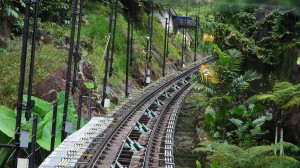
Just to be on the safe side, I keep my eyes closed as the carriage approaches the near vertical section of the climb, or I look at my feet, or to the side, where ferns grow in the dripping rock. Part way up the carriage falters. I tell myself it is changing gear or something, and probably it is, for soon it continues to the top. Later I discover this rail ascends 75m of the steepest tunnel in the world.
We emerge onto a cool, rainforesty hilltop, 880 meters above sweltering Georgetown and the Straits of Malacca, laid out below. Roads branch off in several directions through the greenery, though most people who have made this excursion gather at a few central attractions – a Hindu temple, a mosque, a café, a small playground, and an owl museum. The most popular option, though, is to be photographed, with the fabulous view in the background.
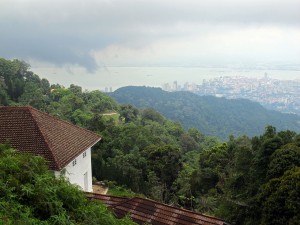 The outlook is rather hazy today, but we are lucky, as I have read that the rains have been heavy up here this week, causing several landslides onto the roads that wind around these hills. Some visitors are driven by golf buggies to the monkey gardens somewhere below, but we decide to walk to the Bellevue Hotel, a little way through the trees, beside a sign pointing to a “bird garden”. Besides, we’d like some lunch.
The outlook is rather hazy today, but we are lucky, as I have read that the rains have been heavy up here this week, causing several landslides onto the roads that wind around these hills. Some visitors are driven by golf buggies to the monkey gardens somewhere below, but we decide to walk to the Bellevue Hotel, a little way through the trees, beside a sign pointing to a “bird garden”. Besides, we’d like some lunch.
The Bellevue, on its brochure, is said to be “once a historic residence of Mr. Halliburton, the first Sherriff of Prince of Wales Island (Pulo Pinang); dating back to the early 18th century under the British East India Company” and the site is hence named “Halliburton’s Hill”. We find the dining room by walking through a central corridor – it is not a grand place, rather, a really pleasant large house. The dining room extends on to a wide 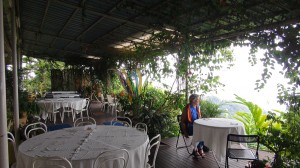 veranda set in its beautiful garden, with wonderful views of the sea. Inside, it is set up as if for a banquet, as if a group of guests is about to arrive. When we call out, as no-one is around, an elderly waiter appears to say yes, of course, be seated, and we find a table overlooking the greenery.
veranda set in its beautiful garden, with wonderful views of the sea. Inside, it is set up as if for a banquet, as if a group of guests is about to arrive. When we call out, as no-one is around, an elderly waiter appears to say yes, of course, be seated, and we find a table overlooking the greenery.
The gentlest of breezes is blowing and some soothing music begins to play quietly – it is the mesmeric sound of Enya. Red passionflowers twine down from the roof above and ginger flowers in the garden at our feet, along with many other exotic tropical species, some of which I’ve never seen. We walk down to the garden’s edge while the food is prepared and look out over the misty Straits below, and the misty forested rise just to the north, where the roof of an old, large, Malaysian bungalow and several similar out-buildings can be seen. This peace here, after the heat and crowds, is dreamlike.
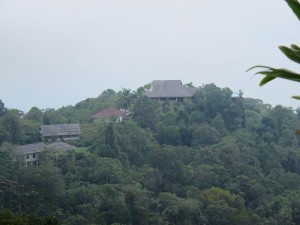 The waiter tells us the bungalow is the now abandoned Crag Hotel, once also an Officers Mess for the British Army, and developed by the Sarkies brothers in the late 19th C. These ethnic Armenians came originally from Isfahan, Iran, and also built such iconic SE Asian delights as the Eastern Oriental Hotel here in Penang, and Raffles in Singapore .
The waiter tells us the bungalow is the now abandoned Crag Hotel, once also an Officers Mess for the British Army, and developed by the Sarkies brothers in the late 19th C. These ethnic Armenians came originally from Isfahan, Iran, and also built such iconic SE Asian delights as the Eastern Oriental Hotel here in Penang, and Raffles in Singapore .
Michael and I decide to walk to Crag Hotel after leaving Bellevue, as it looks so close. But after toiling up and down some seriously steep roads in increasing humidity, meeting one major landslide, and with no idea which direction to take now that we cannot see from above, we return to the funicular station, and continue in the opposite direction. We are wandering for pleasure, but also in search of other colonial era bungalows, although few homes were ever built here, as the area is a water catchment for the city below. Some houses we do make out are hidden along steep private driveways, or can be glimpsed only above treetops, but we do walk by one that is enticingly close, behind a high clipped hedge on the roadway. Why this enchantment with old houses? I think it is to do with satisfying the imagination, and in this tropical region, two deep connections come together, for me.
Mauve flowers drop from tall roadside trees, and Michael sees the most enormous centipede making its way on a thousand legs across the damp bitumen. We watch, fascinated by its busy legged progress, to be sure no cars will flatten it. There aren’t many cars, though. It’s quiet. The grass is rampant and the soil wet and red, reminding me again, by its rich clean smell, of my early childhood in subtropical northern NSW. That is it! The colonial houses (a combination of loved memories and Enid Blyton stories), the vegetation ,the climate, its perfumes, the sea nearby, the feeling of the past that envelopes much of this place as it does Georgetown itself, brings me full circle to the mystery and allusions of my earliest years. This particular journey from Australia is much about that, for me, following on the enormity of my mother’s dying and death. It was so subsuming, so deeply transporting, that I need now to reassess my place in the world, the past, the future, my formative mythologies and emotions. I hope it will be a truer connection to the world than I have achieved before. But who knows?
and Michael sees the most enormous centipede making its way on a thousand legs across the damp bitumen. We watch, fascinated by its busy legged progress, to be sure no cars will flatten it. There aren’t many cars, though. It’s quiet. The grass is rampant and the soil wet and red, reminding me again, by its rich clean smell, of my early childhood in subtropical northern NSW. That is it! The colonial houses (a combination of loved memories and Enid Blyton stories), the vegetation ,the climate, its perfumes, the sea nearby, the feeling of the past that envelopes much of this place as it does Georgetown itself, brings me full circle to the mystery and allusions of my earliest years. This particular journey from Australia is much about that, for me, following on the enormity of my mother’s dying and death. It was so subsuming, so deeply transporting, that I need now to reassess my place in the world, the past, the future, my formative mythologies and emotions. I hope it will be a truer connection to the world than I have achieved before. But who knows?
We return to the funicular station and line up behind a gaggle of happy young women in colourful hijab, the Malaysian headscarf called “tudung”, or simply “cover”. It is becoming ubiquitous, though was not so until quite recent years, yet the women seem independent and unrestricted, in general, as their smiling faces and giggling girlfriend outings tell.
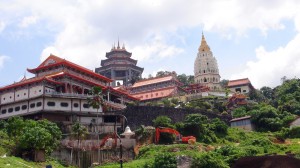 At the bottom, we catch the bus to the Kek Lok Si temple nearby. This colourful complex of pagodas (the earliest begun in 1890), gardens, a turtle pond, shrines, monastery housing and many, many shops is now crowned by an enormous, serene faced (30.2 metre) bronze stature of Kuan Yin, Goddess of Mercy. In the carpark before the entrance is a line of sculpted seers and teachers of ages past.
At the bottom, we catch the bus to the Kek Lok Si temple nearby. This colourful complex of pagodas (the earliest begun in 1890), gardens, a turtle pond, shrines, monastery housing and many, many shops is now crowned by an enormous, serene faced (30.2 metre) bronze stature of Kuan Yin, Goddess of Mercy. In the carpark before the entrance is a line of sculpted seers and teachers of ages past.
The whole elaborate confectionary is a huge tourist drawcard, especially to visiting Chinese, both from Malaysia and increasingly, enormously, from China. Michael commented that the Chinese, having destroyed their cultural past and forbidden religion for so long, now seek to refind it in other countries – an interesting and most plausible theory. There is much real beauty in the Kek Lok Si, but again, it becomes satiating, almost a theme park of Chinese Buddhism (what else can we put in? oh yes, let’s have that too). And the lines of shop stalls at the entrance, and even at places within the complex, are certainly not in tune with the message of Buddhism – but nor would the commercialism of the Via Dolorosa, the Way of the Cross in Jerusalem, advance the message of Christ. Such is the way of the world. However, we were glad to buy a cool drink, while refusing offers of t-shirts, snow storms with encased gold Buddha, etc.
Outside, we catch a taxi back to Hutton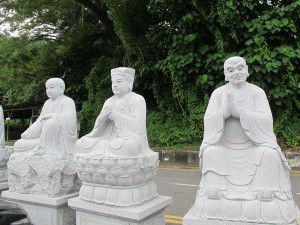 Lane. The driver is Indian Malay, a tired, informative man, who tells us of the enormous expense of living in Georgetown now, and the concern he feels at the divisive tactics of politicians in these days, who are subtly but effectively pitting the various communities against each other for their own power gain. Once, he said, we all lived side by side as brothers, whether Chinese, Malays, Indians. He is angry with the influence from Pakistan and the Middle East that promotes such division (and the Islamisation of society in other ways, such as the wearing of the tudung). Later, we would read in the newspaper the demands of an Islamic cleric that people must unquestioningly obey the leaders, or be going against the laws of Allah. Moreover, a controversy had broken out about Christian leaders in Malaysia who had used the word “Allah” when speaking about God. Although the Christians claimed they were merely speaking in the language of local understanding, as had been done for many years, they must now be prohibited from using the term “Allah”. Later, Michael finds an article (by the wonderful Waheed Ali) on this very topic: First the Islamic car, now you can’t say Allah.
Lane. The driver is Indian Malay, a tired, informative man, who tells us of the enormous expense of living in Georgetown now, and the concern he feels at the divisive tactics of politicians in these days, who are subtly but effectively pitting the various communities against each other for their own power gain. Once, he said, we all lived side by side as brothers, whether Chinese, Malays, Indians. He is angry with the influence from Pakistan and the Middle East that promotes such division (and the Islamisation of society in other ways, such as the wearing of the tudung). Later, we would read in the newspaper the demands of an Islamic cleric that people must unquestioningly obey the leaders, or be going against the laws of Allah. Moreover, a controversy had broken out about Christian leaders in Malaysia who had used the word “Allah” when speaking about God. Although the Christians claimed they were merely speaking in the language of local understanding, as had been done for many years, they must now be prohibited from using the term “Allah”. Later, Michael finds an article (by the wonderful Waheed Ali) on this very topic: First the Islamic car, now you can’t say Allah.
The next day, we had further insight to this island’s colonial past, when due to a posting by my cousin Stuart, who is an aficionado of family history, we visited the old Christian Cemetery to search for the grave of their ancestor Jessie Henriette Cooke, who died in 1868, at the age of 16. Her father had been a General, stationed in Madras. The cemetery, beside a busy modern road, is protected by a moss covered wall and lines of frangipani trees, their creamy flowers strewn on the grass and footpath. Other, larger trees sprout moss and ferns, as do many of the headstones and tombs. It is picturesque and peaceful. We found Jessie Cooke’s grave,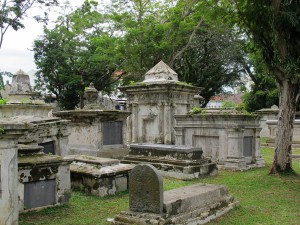 beside the grave of Francis Light, the founder of the East India Company township here – Georgetown. Other headstones tell of tragedies beyond present comprehension in the ‘developed’ world, at least, – families who lose one baby each year of disease, or the wife and baby both; another wife was “drowned at sea”. Europeans did not make old bones, then.
beside the grave of Francis Light, the founder of the East India Company township here – Georgetown. Other headstones tell of tragedies beyond present comprehension in the ‘developed’ world, at least, – families who lose one baby each year of disease, or the wife and baby both; another wife was “drowned at sea”. Europeans did not make old bones, then.
Nearby is the excellent museum of history, where we read of the arrival of each community, and their influence, including the Japanese occupation during WW2. It is all too much to speak of here, where I have already gone on too long, but we will include some of the photographs. Needless to say, I loved the history museum and felt it helped fill out my understanding of the people and atmosphere of Penang Island today. And at our next destination, Langkawi Island, we were to have many more chances to observe the cultural diversity of fascinating Malaysia.
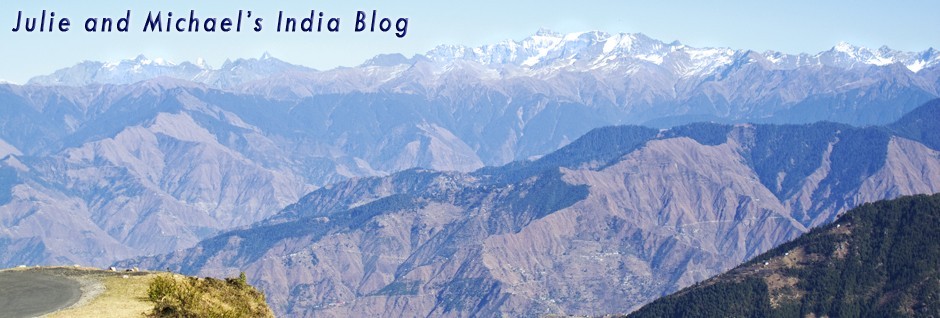
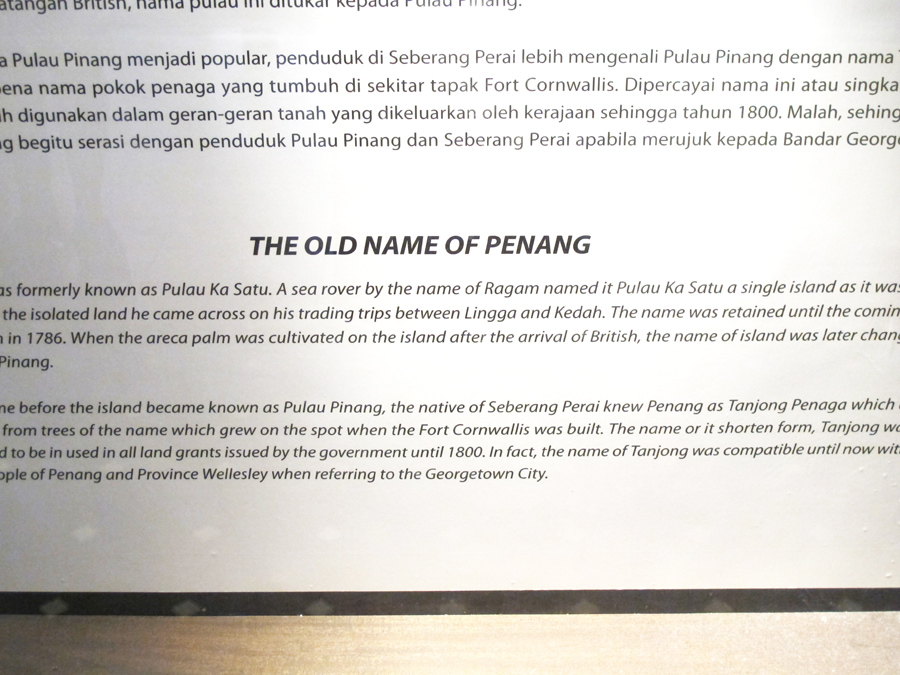
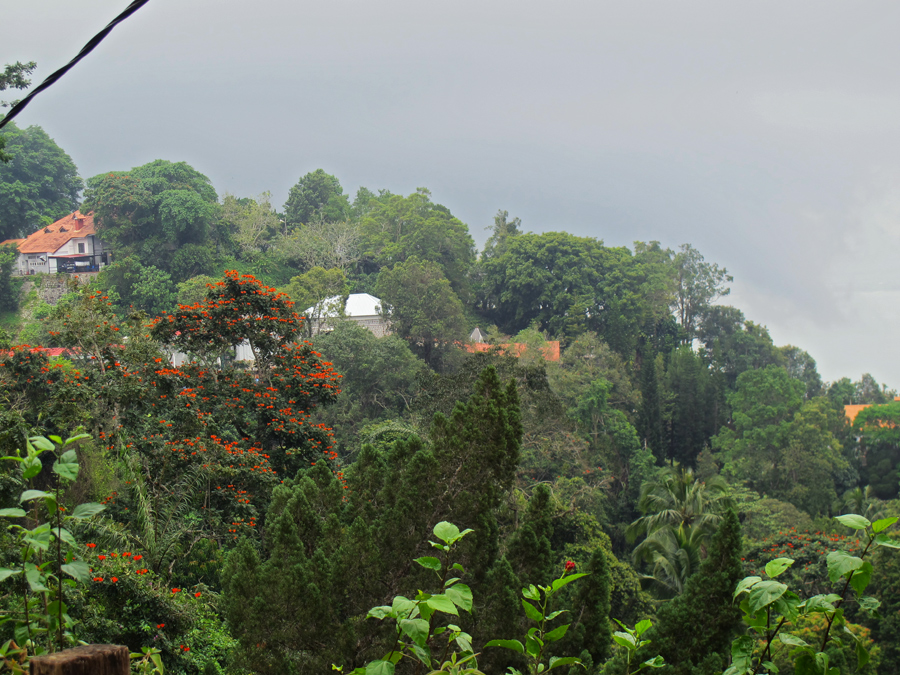
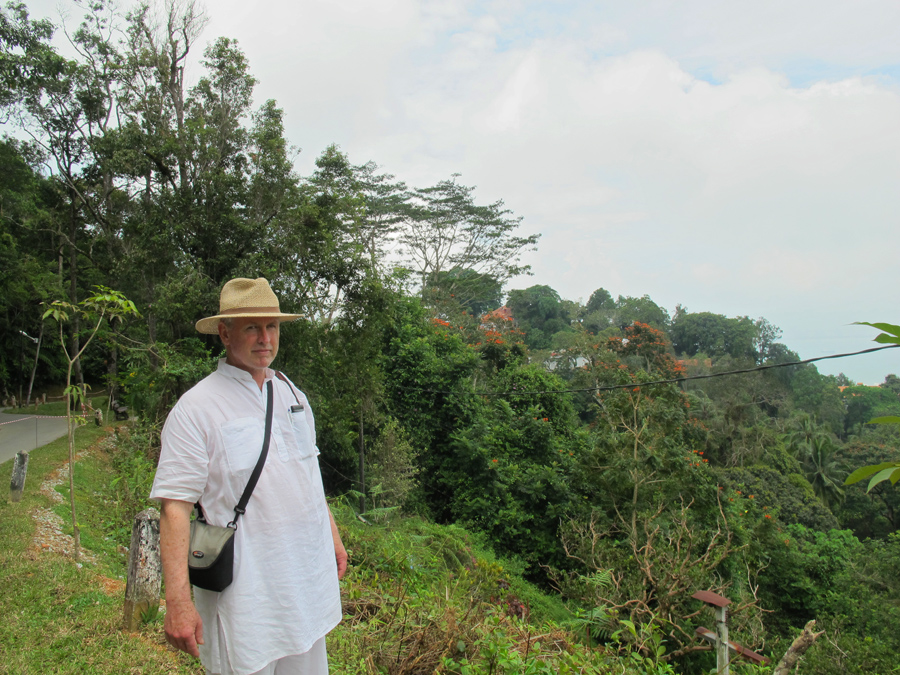
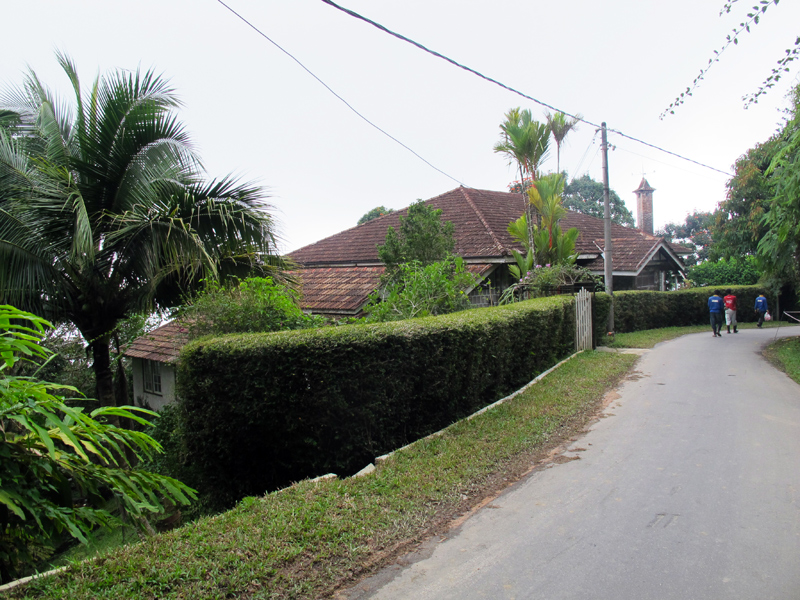
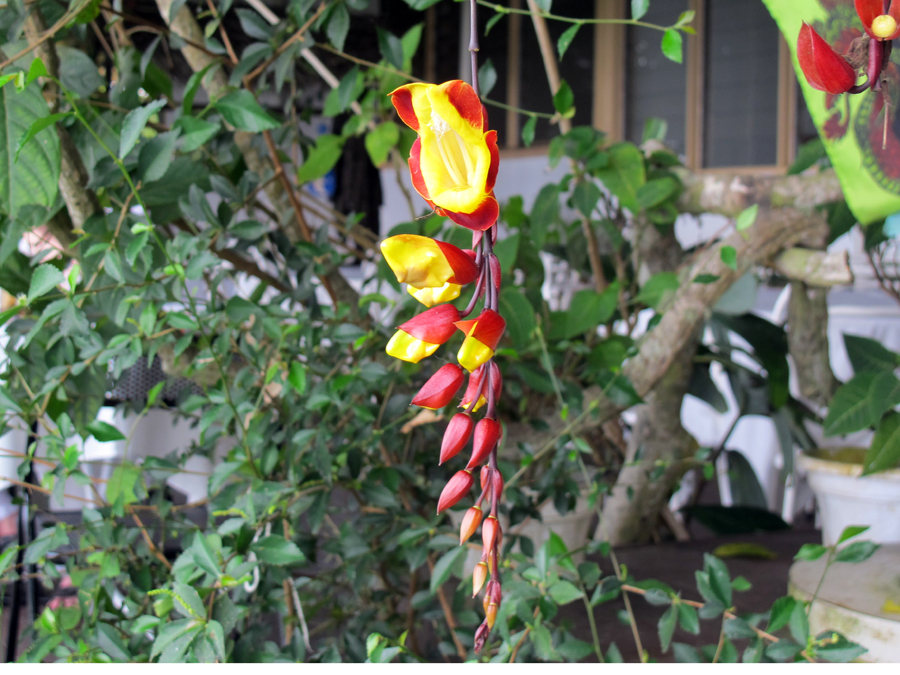
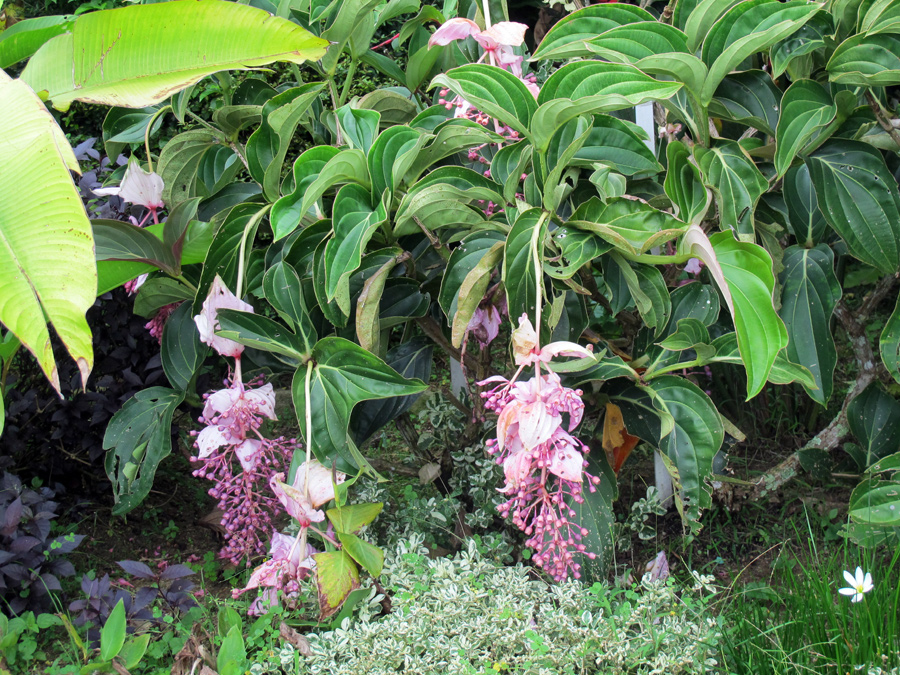
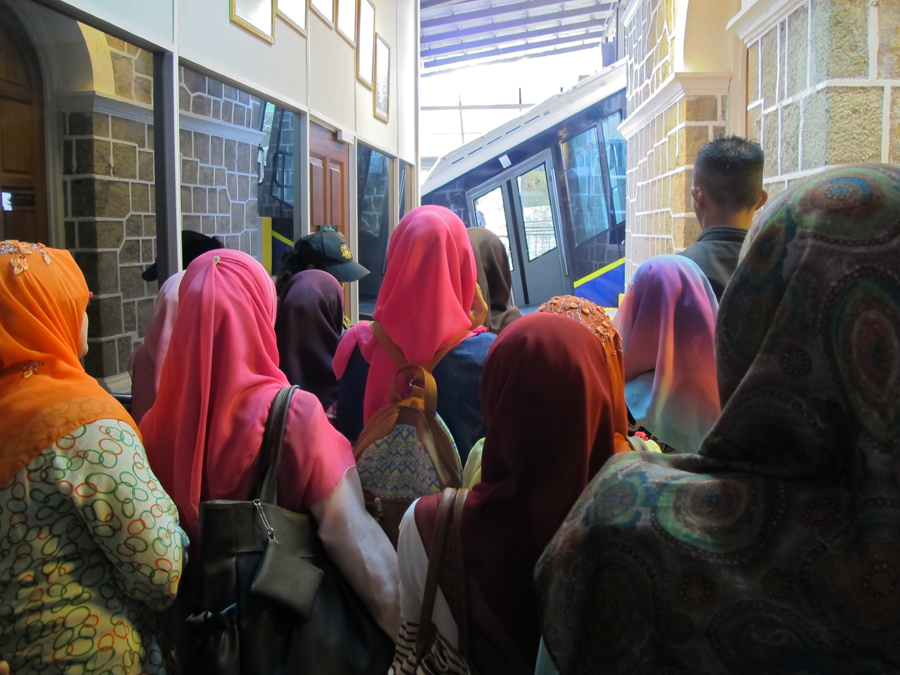
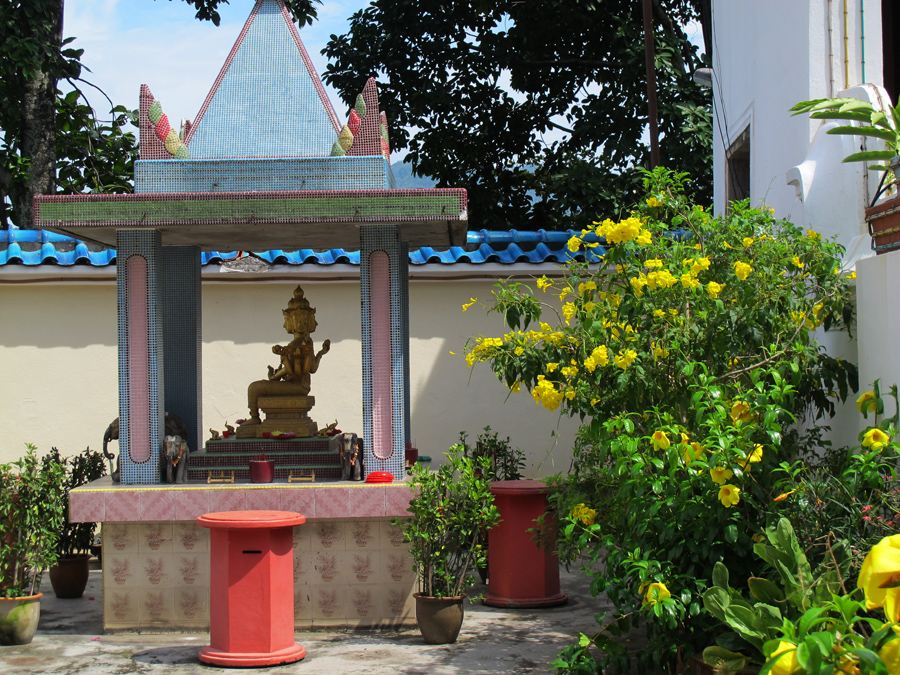
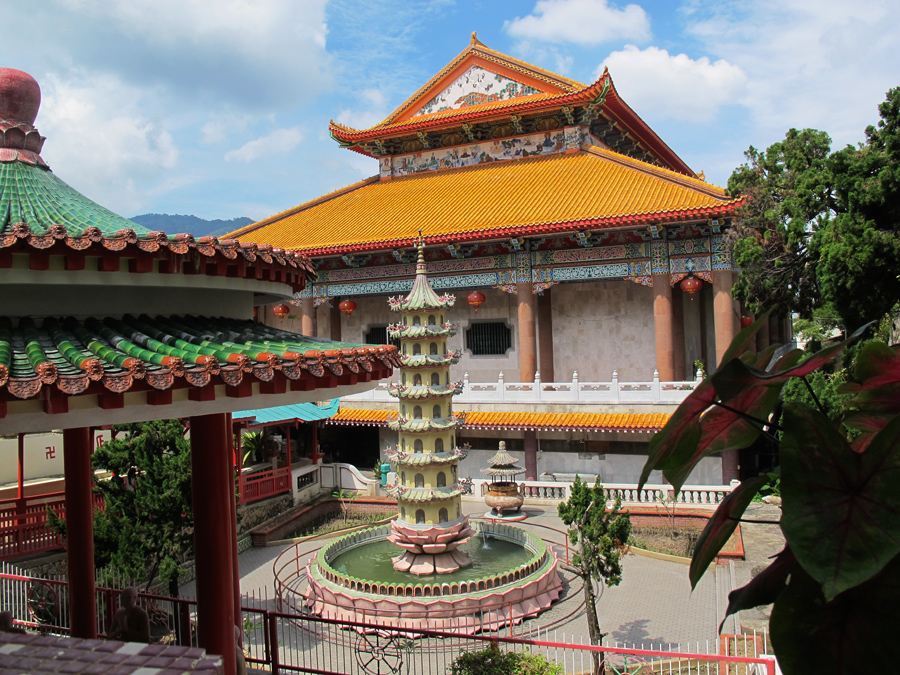
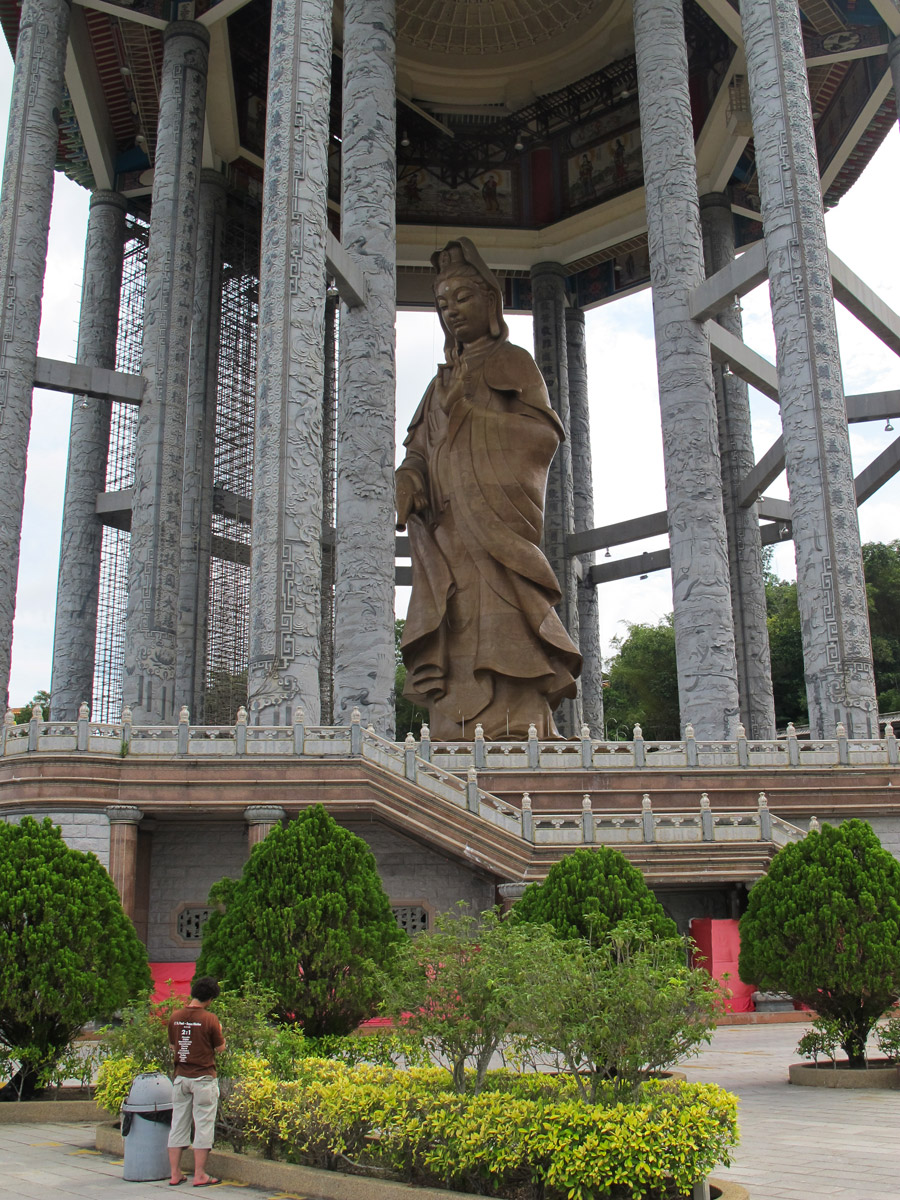
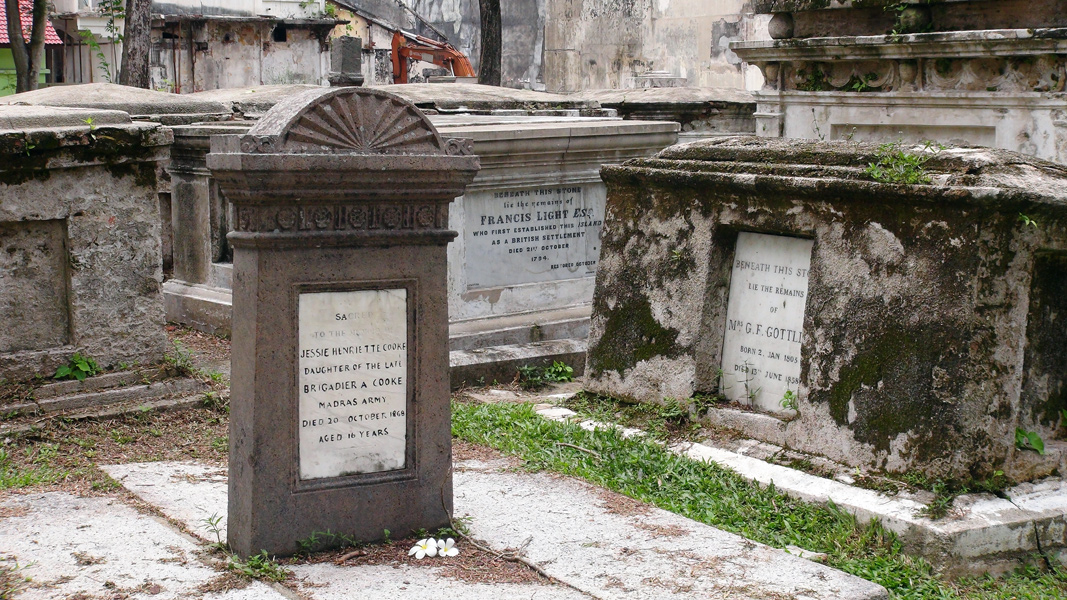
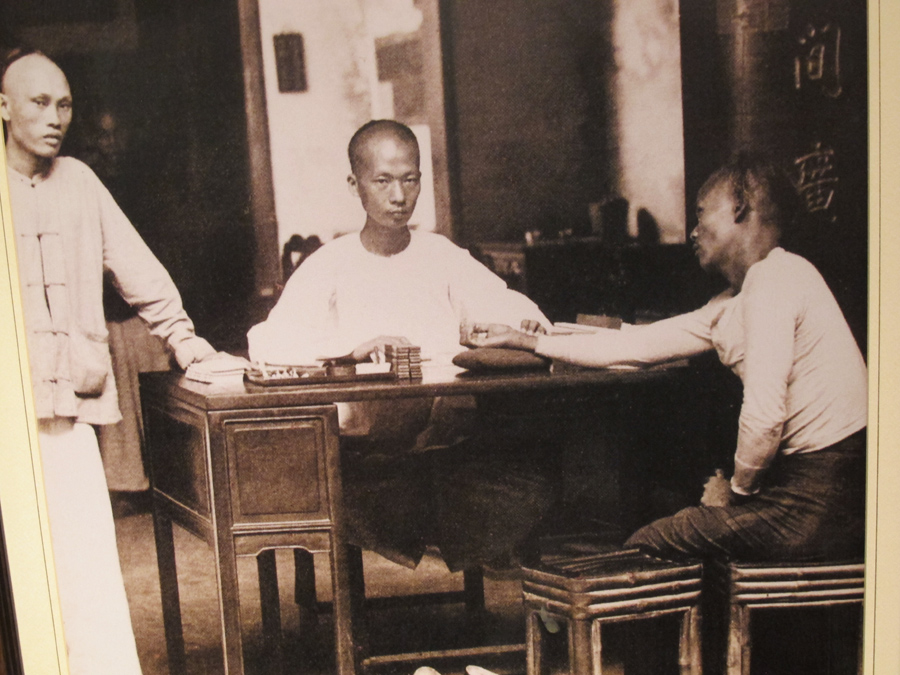
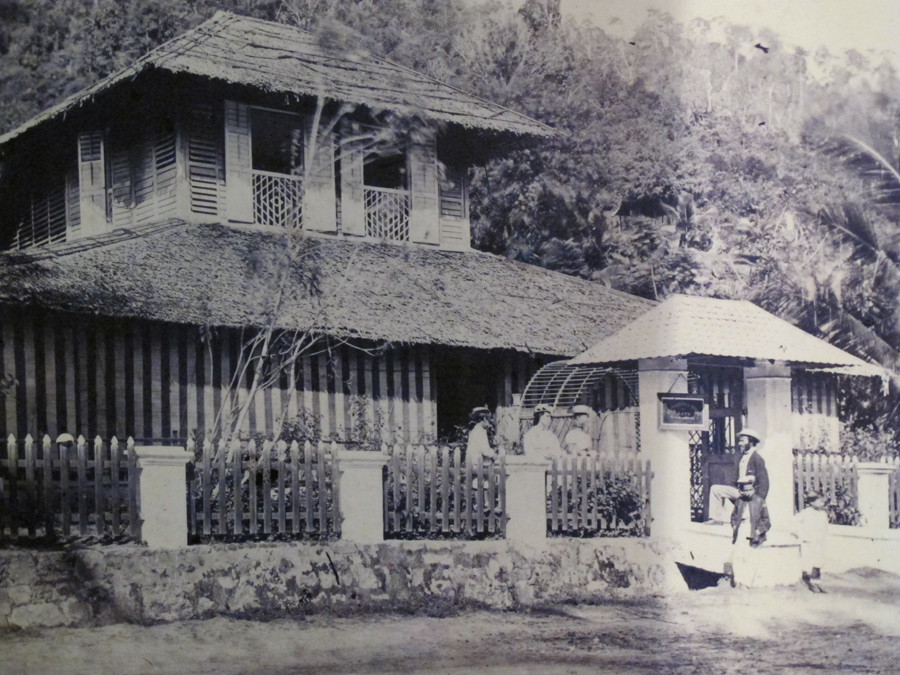
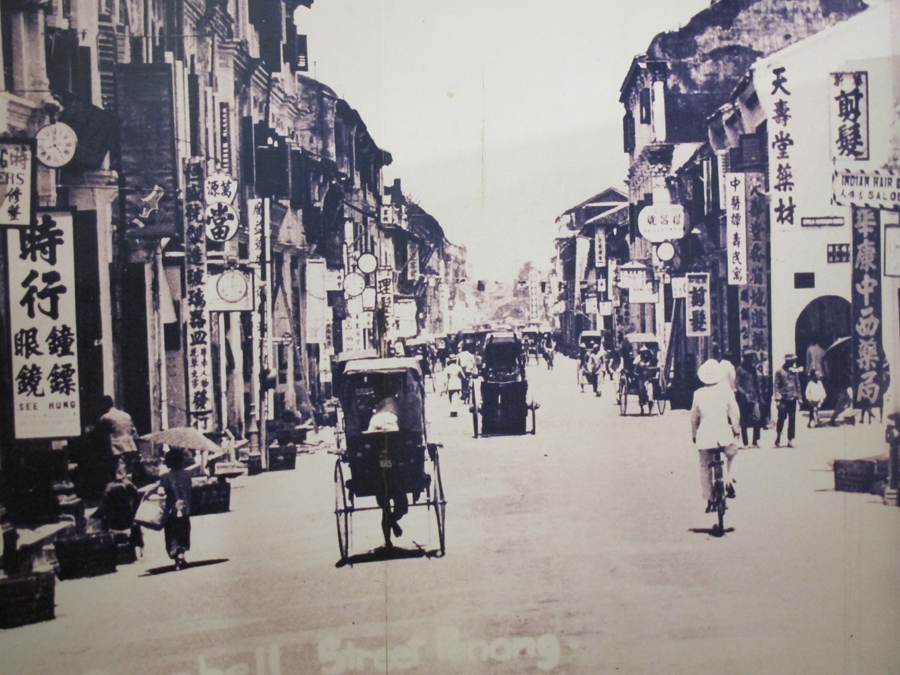
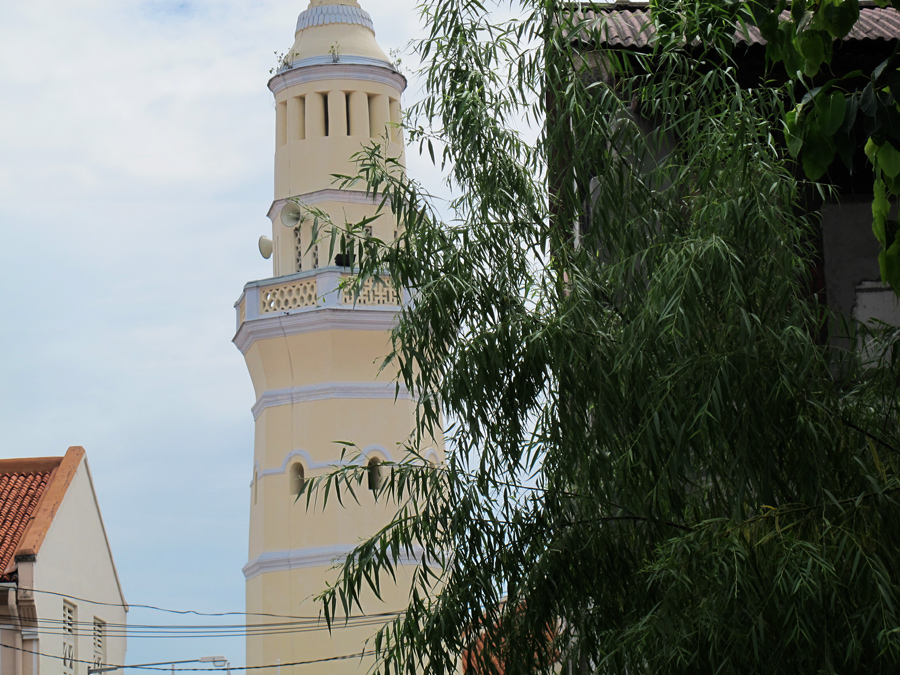
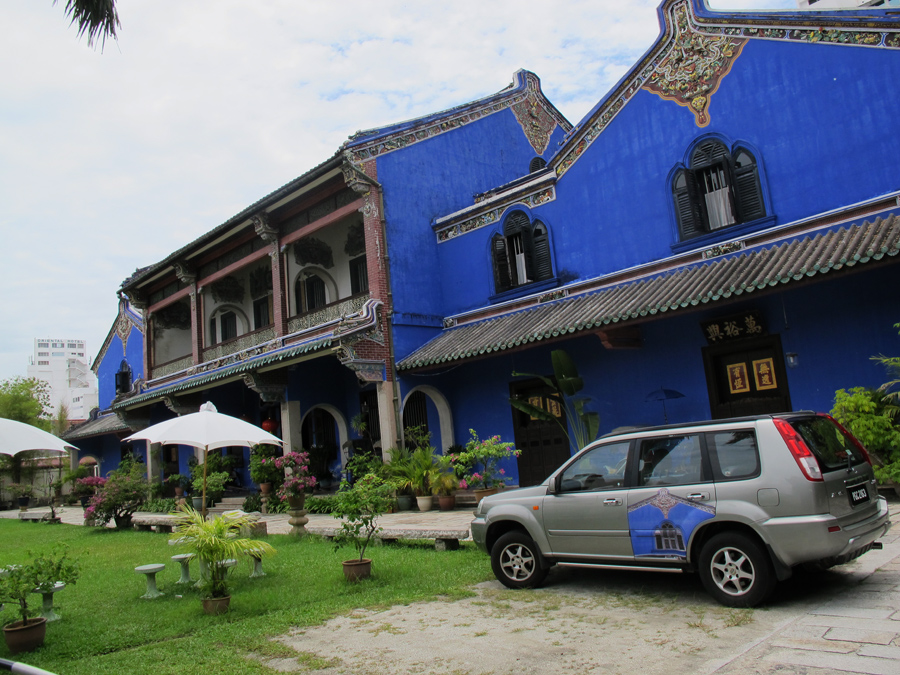
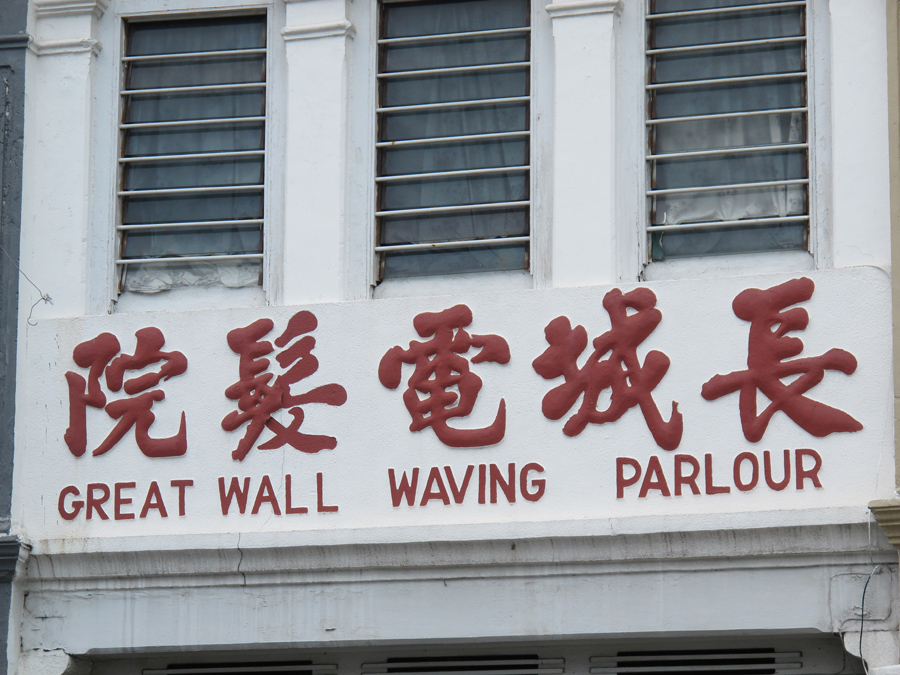
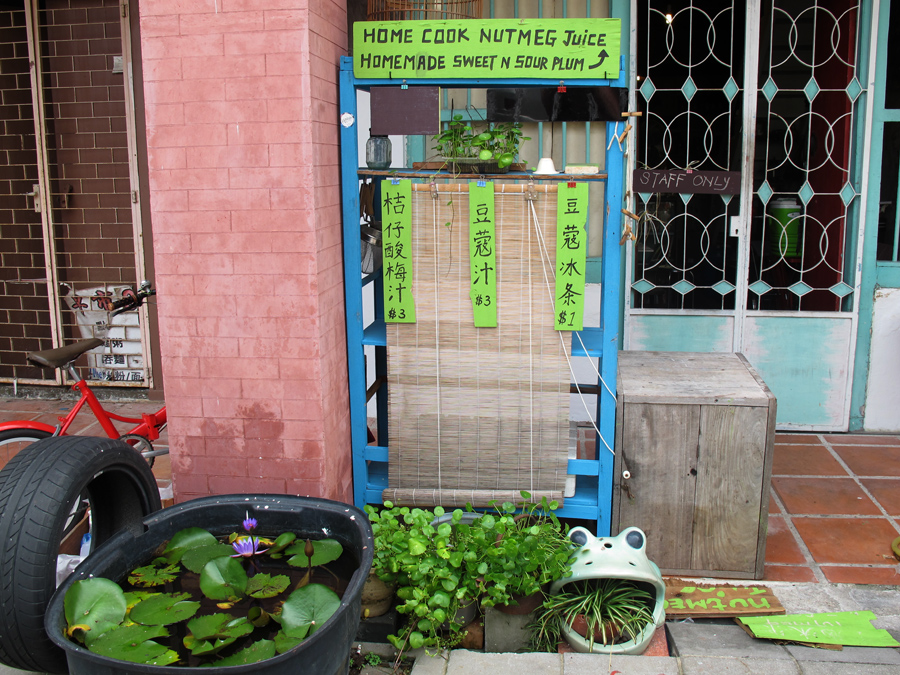
What a lush and fecund paradise, especially to Australian eyes, now stinging with bitter, hot, dusty, dry winds, which are desiccating the country. And see, Julie, you can grow waterlilies successfully in large, deep bowls. We saw oodles of these little waterlily water gardens in China. Perhaps yours wasn’t getting enough sun.
Speaking of China, I wonder what a Chinese tourist would think about Michael’s comment. I’m hoping some will post here why they travel outside their own country. Probably for the same reasons we all do — for curiosity, pleasure, and because they can afford it. Our host in China commented that the best thing about the Cultural Revolution was that it was short, and now Chinese culture is once again flourishing in its own country. That’s why tourists go there, so I guess the Chinese can ask the same question about foreign tourists — what do they find in China that they don’t find in their own country?
After centuries of secularism, consumerism, and scientism, Western culture has undergone its own Cultural Revolution, and I find in many other cultures the spiritual qualities missing in my own. I guess large, deep, intricately hand decorated, hand-thrown bowls full of waterlilies, left unguarded and unvandalised in a public place would be something I would never see on the streets of Australia.
Thanks for reading this, Joan. You always write such thoughtful comments.
I think my waterlily did not like the minus 10 frosts, but possibly it had not enough sun, too. It’s a harsh climate in Armidale at times, for sure. That bowl in the above picture is actually plastic or perhaps fibreglass (sadly, but also I love that use of otherwise discarded items) but I imagine you saw lots of the hand thrown ones in China, as in other SE Asian countries.
I agree too that now Chinese people have more money, they are curious about the world just as everyone is, and want to shop in Paris, see the sights in Sydney, or go for an island holiday, as we saw in Langkawi. The Chinese tourists we saw in Penang were certainly flocking much more to the Chinese temples, clan houses (where they may have ancestral ties) and restaurants than to the other “attractions” (there were none that day at Penang Hill, nor at the museum, not in Little India, nor the Indian temples, and few at the famous “colonial district”, for example, except for wealthy guests at the Eastern and Oriental Hotel). But I have also noticed that British people love to go to places in India that most reflect aspects of the British Raj – Darjeeling is popular for that. As you see from my writing , I also search for vestiges of the past. “Identity” is a big issue!
We also seek out the exotic for a similar reason. We define ourselves by what we find in the “other”, as well; the daily world at home becomes mundane and we need new eyes to see it. It’s always interesting to me that in India (actually at home on weekends too) Michael loves to wear Indian clothes such as lungis and kurtas and loose white cottons – very practical and aesthetically pleasing. But Indian men prefer western style trousers and shirts, often of synthetic blend – hot! yet practical in a different sense. Then they are very pleased (or amused?) to see M’s attire – mostly they love it.
The world these days is, I guess, more than ever in history interconnected, for better and for worse. I just hope it doesn’t become overly homogenised – but that is another issue, and the basis of many political power games.
Another thoughtful and evocative blog Jule. I just love the term “funicular rail”, it reminds me of “runcible spoon” from the Owl and the Pussycat poem that my dad used to recite to us as small children! It looks like Penang Hill is the place to live. I found that when we were travelling I was attracted to some of the colonial era houses, I remember a rather dilapidated one in Dalhousie and one in Solo (Indonesia) that almost evoked a sense of deja vu. Re the tudung, when we were in Indonesia, we were struck by the proliferation of new modern large mosques in even very small villages, and when in Jakarta we saw middle aged and older women in western clothes, and schoolgirls wearing the headscarf. I agree with your comments about modern homogenisation, it is the capitalist curse, I loved the pre-homoginisation photo of Old Chulia street, and the Great Wall Waving Parlour. Thank you for sharing your experiences.
Thanks Joan, I knew you’d empathise with this! Of course, I had you in mind, thinking of the smell of red soil, the lushness of the Tweed Valley. The new mosques are also noticeable in South India, party I guess because so many men go to the Gulf for work. But as in Indonesia, where no-one else will provide schooling (and religious education), the Saudis do. Of course there are lots of new mandirs too (Hindu temples) with India’s increasing wealth.
I love “funicular” too ,but can’t write it without singing “Funiculi Funicular funiculi funicalar” – do you remember that song? http://www.youtube.com/watch?v=MJd-SHzqUC4
Julie xx
Julie, that was a very informative supplement to Michael’s comment, and I’m pleased I said something that brought it out. The Chinese, those who can afford it, visit their own historical and cultural sites in China in vast droves as well. For the first time in their history, ordinary people have access to education and money, especially education about themselves, albeit it is still very biased, in the same way our current government will once again try to skew what is taught to school children.
One young woman was astonished that westerners believed that Tibet was its own country, and not part of China. Of course, they are not told that China invaded Tibet in 1949. She asked me why I thought this, and I explained that Tibet has its own language, culture, religion, history, and customs, which are quite different to those of China. I didn’t say anything about the invasion. But, unlike a certain MK, whom we both know, she was very open to this and did not react with hostility. I found that a very good sign.
The Chinese are certainly rediscovering themselves. Fortunately the Cultural Revolution was short, like the one in the 3rd century BCE it was modelled after, and hence the custodians of culture are still alive and can pass on the knowledge, often, but not always, in a modernised format. Watching those 8 year old kids practise their calligraphy at night school was heartening. They didn’t look like they were over-homogenising, at least under the stern glare of the old matriarch, dressed in traditional pre-Mao clothing, who presided over a youngster, probably her grandson. The look on her face was definitely anti-homogeneity. I just hope they can keep it up under the pressure of modern technology – mobile phones, internet, etc.
I would be interested to hear the thoughts of those who visit Chinese religious sites outside their country. It sounds like a kind of pilgrimage to parts of themselves from which they’ve been cut off, part of their process of self-rediscovering, as Michael intimated. Education, of course, is essential for curiosity for other cultures to develop, and I don’t know if the Chinese get enough of this to make them as curious as we might be about other traditional cultures.
Hi Joan, the idea of Chinese ‘rediscovering’ themselves does accord with my speculation that it could be connected to their truncated history, but I’m not sure my comment can be easily proven in any way. It remains a speculation that may or may not have some truth to it. It would fit with the whole national identity issue which is much talked about. Penang and Langkawi were the best places we have been to observe this juxtaposition of cultures, both internal Malaysian differences as well as foreign visitors. It was hard not to ponder these cultural distinctions and ask why they may be.
It has occurred to me through contact with Chinese people I have known, that they have a very strong fascination to things from ‘old China’. Perhaps because their past has been truncated like few other countries, but I also feel they have a powerful attraction to anything from their own cultural traditions. Again it is an identity issue, but I suspect the details of that are very complex.
One of our main interests in travelling to all these places, is to try to comprehend the changing trends and people we move through. It is both important and unfortunate that we end up generalising, but how else can we get a grasp on it all? There are always individuals who are exceptions, and this happens in India more than any other place. I expect Julie will speak more about these generalisation insights as she progresses, because we are often trying to use them in conversations between ourselves, to help make sense of what we experience. In fact there is even more of this when we try to understand the generations within a culture, as well as different states here in India.
The youth are so often in our face here, that we can’t help try to package these experiences in some ordered way. Julie came out with a great word yesterday, to help this process: attitude. How some of these groups have much more attitude than others, and that attitude becomes quite aggressive at times.
Whatever generalisation we come up with, there will always be an inexhaustible supply of contradictions. Also, travellers away from home rarely represent their home population, as they tend to be the exceptions rather than the rule. I’m thinking in particular of Americans, who seem to be a different species away from home than in their own land. I suspect this is the same for the Chinese.
However, having experienced upfront the rediscovering of Chinese culture, I can attest to its truth. Of course, many Chinese are busy discovering western culture and probably don’t give a stuff for calligraphy, history, ceramics, the I Ching, the Tao De Ching, and Tang poetry. But the ceramics capital of China (Jingdezhen) since the Tang Dynasty (700 CE) is busting with new life since the lifting of the ban on producing cultural objects. You’d think the place had never shut down, except for reminders from dilapidated and abandoned workshops, which once produced enormous quantities of religious iconography for the temples of SE Asia and world class ceramics for collectors at home and abroad. Now it is back in business, and one’s jaw hits the dirt in amazement at the YOUNG people learning these ancient crafts and tirelessly painting the exquisite details onto giant pots, tiles, and statues once again destined for overseas markets and public and private buildings at home.
And in the cities, the galleries and public spaces are full of paintings, sculpture, and ceramics displaying deep cultural roots in modern form. The skills were not lost in the great purge, and even in a glitzy megalopolis such as Xi’an (home of the Terra Cotta Warriors), one can stumble into an entire street dedicated to calligraphy and painting. Given that it is not in the Lonely Planet Guide demonstrates that it’s not a tourist trap, unlike the Warriors. An entire street with nothing but shops selling calligraphy and painting supplies, with YOUNG artists painting and writing in their street stalls. I thought I’d died and gone to heaven.
Perhaps a similar example can be found in the resurgence of icon painting in former Soviet countries, now that the Orthodox church has emerged from hiding. When you prohibit something, you can be sure it will return with a vengeance when your back is turned.
True, things DO tend to return. I’m thinking of very high heeled shoes for women, impractical and harmful, which I thought had gone with the efforts of the feminist revolution! I find it interesting to see the western country’s revival of interest in the 1950s (everything old is new again, as the song says!) which is part of a romanticisation of that era as being wholesome, and more simple than now. In some ways it was. But women were corseted in more ways than one. I hope the Chinese do not return to the tradition of bound feet 🙂
I gave you a CD some time ago of Chinese musicians playing instruments they had had to bury during the Cultural Revolution, had later rescued and brought to Australia. That sort of preservation, amongst others, is thankfully always to be found. Sometimes revivals can be problematic, as occurs with religious fundamentalisms.
Joan R, can you interpret any of the characters in that bottom picture, of the shop house? I love that they are selling “nutmeg juice”, and that little round leafed plant is gotu kola, which is another thing I cannot grow because of the cold (an excellent anti cancer herb, it is said). As for the “Great Wall Waving Parlour”, suddenly it dawned that it is probably a hairdressers!
I did try to read it at first, Julie, but, no, I haven’t learned any of those characters. It probably says, ” Homemade nutmeg juice and sweet and sour plums.” 🙂 I see now that the lilies are in plastic. My lilies grow okay in our ponds despite the winter cold — only the yellow and pink ones are frost tolerant, the yellow do much better than the pink. But I admit I haven’t tried them in smaller pot ponds.
I’ve been thinking about the “cultural differences” issue, and realised I discussed this in my PhD thesis methodology, using a model from psychology, which places the theory of sameness at one end of a continuum and the theory of difference at the other end. The former characterises global thinkers, and the latter, analytical thinkers. Coming from comparative religion, I put myself closer to the global than the analytical, preferring to focus on similarities before differences, but of course sliding along the scale towards difference when discussing that aspect. A person at one end of the scale prefers to emphasise similarity whereas someone at the other end, prefers difference. Both are correct on their own terms.
Chinese women are returning to bound feet in the western format — high heels. Sigh. Women feel they look elegant and sexy in high heels, so as long as society tells them this is true, they will hobble along on bound feet. Young Chinese women love to show their legs. They wear very very short skirts or shorts with white stockings. The tyranny of the hem line. The only mandarin collar on a brocade jacket I saw was on the old woman watching sternly over her grandchild as he squirmed in his seat while writing calligraphy correctly with his brush on his practice paper. Now, that kind of hobbling I approve of.
Similarities and differences – I think I find similarities so blindingly obvious, such a ‘given’, that difference is the marker of interest, to me. I like the world diversified ( but “equal”!)
I remember a comment I read once that some western traveller had found it very sad that women in the Sudan (I think it was) were now using plastic containers to carry water rather than the once traditional pottery ones. A response was that the plastic containers were so much lighter that the women were thrilled about them. Of course we an argue for ecological, more long term issues on that, but it’s a good little anecdote.
This is a huge conversation that is going on world wide. It has many political implications, too.
Same day I made that statement about the political implications I read this (“Old Dreams for A New China”) in the new York Review of books:
http://www.nybooks.com/blogs/nyrblog/2013/oct/15/china-dream-posters/?utm_source=feedburner&utm_medium=feed&utm_campaign=Feed%3A+nybooks+%28The+New+York+Review+of+Books%29&utm_content=Google+Feedfetcher
A comment, assessing the article says: “Bid for grounding the Party’s appeal in traditional culture – when for the past 20 years it has been all about wealth and development. Softly shadowed human replace glistening giant buildings. Massive change in tone and manner.”
That’s interesting, Julie. Your observation. I see the differences as being fascinating qualities that sit on the surface and often obscure the unfathomable universal traits that give rise to them. The book and the cover, as it were. It wish for the whole world to see the similarities as “blindingly obvious.” What enormous problems would be solved!!
Thanks, Julie, for the link to the book, Old Dreams for a New China. One posting in particular really hit the nail on the head. If the Chinese are reverting in any way back to Confucian family values, it’s because their social security has been terminated by centralised capitalism and they once again need the support of their family to be educated, looked after in times of illness and unemployment, looked after in their old age, and to pay their hospital bills. All of these things were once provided by the government, but now the iron rice bowl that supported and fed them from cradle to grave has been broken.
What is not said in detail in the comments or review is that traditional Confucianism relied on large families. The one child family is still the rule, although a little relaxed in places, but where it is enforced, it makes it very difficult for single children to support their parents, their grandparents and the parents and grandparents of their spouse, especially if they live in a city apartment. That the government has abandoned social support and now expects the family to take over is putting enormous strain on individual working young people, if they are lucky enough to be working. I’ve just finished a book, The End of the Chinese Dream, which goes into these problems in detail. Dream on, China!
Joan I reply at last! Re “blindingly obvious” -the emphasis is on the “blindingly” part. It’s like the air we breathe ,which we rarely think of, it is so all-apparent. That’s a really interesting comment regarding Confucian values replacing Communist ones because of capitalism. And, of course it IS impossible because of the one child policy.
This is NOT a post that adds to the discussion -I’m a bit brain dead just now with the tension that comes when you are about to go to a new place -but wanted to say thank you for your always valuable input.
Can I ask Julie, are you the daughter of Joan Marsh from Orient street Kingscliff that moved to Armidale around 1999.
Thank you
Michelle Lynch
Yes, I’m Joan’s daughter.
Julie